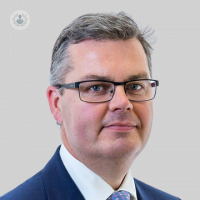Understanding glaucoma in children
Written in association with:Paediatric glaucoma is a rare condition, however, it can be visually significant for the children it affects. Unlike older adults, who are usually at risk of developing glaucoma, children who present with this condition have more years of life ahead of them, and therefore treatment and preserving vision is extremely important. How glaucoma is treated in children can differ, and here Mr John Brookes, a leading ophthalmic surgeon explains the various treatments available and the most recent innovations made in this field.
Glaucoma in children is referred to as primary congenital glaucoma (PCG) and although it is a rare disease, it is responsible for 5% of childhood blindness worldwide.

The main symptoms of paediatric congenital glaucoma include:
- Epiphora – watering eyes.
- Photophobia – sensitivity to light.
- Blepharospasm – abnormal contraction, or twitching, of the eyelid.
These symptoms are a result of elevated intraocular pressure, which causes splits in Descemet’s membrane, which is found between the stroma and endothelium. The good news is that, with appropriate treatment, children can be ‘cured’ from congenital glaucoma.

What treatments are available for treating paediatric glaucoma?
Traditional angle surgery has been the gold standard for all glaucoma surgery and includes both goniotomy and trabeculotomy.
- Goniotomy has had good success rates in children with pressure control gained in 70-80% of cases. During this procedure, a special lens called a goniolens is used to see the inner structures of the front part of the eye. An incision is made in the trabecular meshwork, which is the group of canals needed to drain the eye of fluid. This new opening allows fluid to find a way out of the eye, reducing eye pressure.
- A trabeculotomy also has similar success rates and lowers intraocular pressure by creating a small hole in the wall of the eye (the sclera) covered by a ‘trap-door’. Through this trap-door, fluid can drain from the eye, controlling eye pressure and preventing further loss of vision from glaucoma. This is the most common form of angle surgery performed for treating this condition.
What recent innovations have been made in paediatric glaucoma?
There have been changes and advancements made in performing angle surgery for paediatric glaucoma cases. These include the use of endoscopes in goniotomy surgery, 360° trabeculotomy and viscotrabeculotomy. To date, endoscopic goniotomy surgery has not had great success in controlling intraocular pressure, however, its use in treating paediatric glaucoma has not been sufficiently studied and reviewed.
- 360° trabeculotomy:
This method offers the advantage of precision and only needing one surgical procedure to successfully control eye pressure. However, this procedure can be very time-consuming and complex, but it does hold promise and is my preferred method of angle surgery.
- Viscotrabeculotomy:
Before and after a traditional trabeculotomy is performed, an ocular viscoelastic material is injected into the eye which is said to prevent post-operative haemorrhage and fibroblastic proliferation. Fibroblasts are important in the process of tissue repair as they produce collagen and respond to tissue inflammation, hence, they can be detrimental when recovering from glaucoma surgery.
Although congenital childhood glaucoma is rare, preventing vision loss and prolonging their vision for as much of their lives as possible is very important. Without this, affected children are unable to achieve a sighted and independent life.


